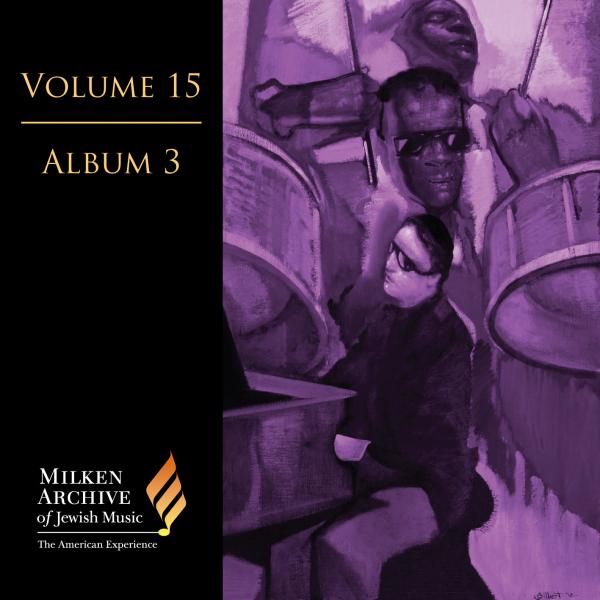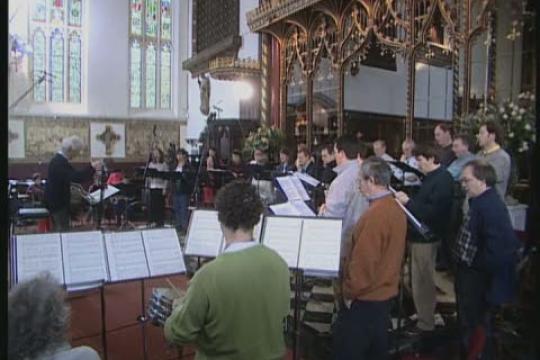Tracks
Liner Notes
Among major Jewish American composers who have devoted a significant part of their gifts to Broadway, film, and American musical theater—Jerome Kern, Irving Berlin, Harold Arlen, Jule Styne, and Stephen Sondheim, to name only a few—Kurt Weill was one of the very few, along with Leonard Bernstein, to write even a single synagogue piece. His setting of the kiddush, however, was his only expression of the Hebrew liturgy outside the context of his Jewish pageants.
In 1943, Cantor David Putterman of New York’s Park Avenue Synagogue began an annual program of commissioning established and promising younger composers from the general music world—non-Jews as well as Jews—to write for the liturgy. In this visionary concept, which blossomed into one of the most vital and long-running chapters in the history of sacred music in America, Cantor Putterman was following a precedent created in 19th-century central and western Europe by such legendary cantors and cantor-composers as Salomon Sulzer (1804–90) in Vienna and Samuel Naumbourg (1815–80) in Paris. They had invited some of the leading opera, theater, church, and concert composers of their circles and communities to contribute Hebrew prayer settings to their anthologies, and these settings joined the regular repertoires of their synagogues. Some of those works, such as Jacques Fromenthal-Halévy’s elaborate setting of min hammetzar, one of the Psalms of the hallel service for Festivals and other special liturgical occasions, eventually became standard repertoire pretty much throughout the cantorial world.
Prior to Cantor Putterman’s program, other American synagogues—notably Temple Emanu-El in New York and Temple Emanu-El in San Francisco—had commissioned liturgical works from important classical composers. But such commissions had been pursued on occasional bases, as one-offs, even though Lazare Saminsky, New York Temple Emanu-El’s music director, had hoped as early as the 1920s to develop an ongoing series. Subsequently, throughout the 20th century and into the 21st, numerous Conservative and Reform congregations have been involved in occasional commissioning, sometimes as consortia and most often for specific commemorations. But the invited composers have usually been among the ranks of those already primarily associated with synagogue music.
The Park Avenue Synagogue program was special in at least three respects: It was intended to function in perpetuity on an annual basis. It sought primarily to encourage serious artists, especially those outside the specifically Jewish liturgical field, to contribute to Jewish worship—often for the first time—each according to his own stylistic language without imposed artistic conditions. And its goal was to accumulate an expanded repertoire of sophisticated works for American synagogue services whose worshippers were no strangers to the variety of contemporaneous developments in the concert world. Cantor Putterman established and secured a permanent fund for the program, whose fruits would be premiered at a special Sabbath eve service each year. These became important cultural events for the entire New York Jewish community and even found a place on the New York general musical calendar. Beginning in 1950, individual composers were commissioned to write entire services for those annual presentations.
Cantor Putterman turned to Kurt Weill for one of the commissions for the 1946 special new music Sabbath eve service. After discussing a number of possible texts, they agreed on a setting of the kiddush—the prayer and b’rakha recited on Sabbath eve (and, with text variants, on the eves of the Three Festivals and of Rosh Hashana) over a cup of wine to affirm the Divine sanctification of the day. This ritual symbolizes, recalls, and celebrates God’s gift of the Sabbath as the first of the holy days to have been designated in remembrance of the creation both of the world and of the Jewish people as distinct (“ . . . in remembrance of the Exodus from Egypt”).
Perhaps in part because they were not fully aware of the nature, context, and purposes of the Park Avenue commissioning program—nor of the extent of Weill’s Jewish sympathies—Weill’s biographers and other students of his work have sometimes been quick to assume that his enthusiastic acceptance of Cantor Putterman’s invitation related to feelings of guilt or regret at having separated himself from his father’s commitment as a cantor to religious observance and affiliation—or over other, more recent disagreements or ambivalences in terms of their relationship. Thus, one assessment referred to Weill welcoming this commission as “a chance to clear his conscience with regard to his father.” But such conclusions seem hasty, if not superficial.
This was not Weill’s first encounter in adult life with Jewish musical creativity, and there is no reason to believe that conscience or regret played any role in it. Rather, given his involvements with Jewish causes during the immediately preceding years, and his transparent affirmations of Jewish (albeit not specifically religious) identification and solidarity, it would appear that he saw in this commission the purely positive twin opportunity for Jewish and musical expression. There is indeed every reason to believe that he was genuinely intrigued by the prospect of trying his hand (as he had not done since his teen years) at music for actual worship, especially since Cantor Putterman’s policy was to refrain from imposing stylistic or other artistic restrictions. Even if this opportunity did provide an emotional link to his father—and, for that matter, to both his parents and their generation—it also offered Weill at that stage in the evolution of his Jewish consciousness another chance to contribute something to contemporary Jewish life and culture. Moreover, he had shown himself reinterested in Hebrew liturgy more than a decade earlier, when, in preparation for his monumental operatic pageant The Eternal Road (in Volume 17), he had asked for his father’s help in identifying traditional synagogue melodies. He used them throughout the four acts of the work and made ample use of Hebrew liturgy in his subsequent Jewish pageants as well. By 1946 he had also become deeply concerned with his Jewish heritage both personally and artistically in terms of Jewish national solidarity. That concern manifested itself in his involvement with Revisionist Zionist efforts in the United States.
Kiddush was premiered on Friday evening, May 10, 1946, at the Park Avenue Synagogue’s “Fourth Annual Service of Liturgical Music by Contemporary Composers.” It was sung by Cantor Putterman, with the synagogue choir supplemented by a group known as the Hebrew Arts Singers and conducted by Max Helfman, with Isadore Geller at the organ. The other offerings that evening—all composed especially for that service—included settings of ma tovu (in English translation) by Alexandre Tansman; l’ma’an tizk’ru by Nicolai Berezowsky; kaddish by Ernst Levy; tov l’hodot by Arthur Berger; May the Words of My Mouth . . . by Paul Pisk; and two by non-Jewish composers: Roy Harris’s mi khamokha and Psalm 24 by William Grant Still, probably the first black American composer to write for a synagogue service. There was also a new organ prelude by Eda Rappaport and a “Benediction” by Isadore Geller. Also sung that evening were commissioned works from Park Avenue Synagogue’s new music services by Mario Castelnuovo-Tedesco, Paul Dessau, Frederick Jacobi, Heinrich Schalit, Herbert Fromm, Max Helfman, and Leonard Bernstein, whose setting of hashkivenu had had its premiere there the previous season. The printed program stated that the commissioning project was “dedicated to the enhancement of Jewish worship; to a wider diffusion and utilization of the resources of Jewish music; and to the encouragement of those who give of their lives and genius to its enrichment.”
Kiddush was composed during the same time frame in which Weill was working on Street Scene; and indeed, one can discern certain rhythms, accompaniments, and accompanimental figures common to the two works. This kiddush setting is most likely the first Hebrew liturgical piece for worship to reflect so directly the influences of jazz and blues. Weill applied elements of his own theatrical sound and his unmistakable synthesis of popular idioms to his interpretation of the text. The appropriately conservative melodic, rhythmic, and harmonic imprint of blues never obscures or predominates over the liturgical function and the dignity of synagogue worship that he might well have recalled from his youth. Choral passages resonate with the best Broadway sonorities of the time, yet the original solo lines are not entirely divorced from a traditional cantorial flow—even though those, too, are subtly infused with jazz and blues flavors. Those lines and the choral parts are integrated and intertwined throughout, creating a unified effect. Overall, one senses an aura of nostalgia.
Weill clearly intuited the theatrical possibilities in the kiddush text, even as a “miniature” musical statement; and he appears to have understood that liturgy and theater are not necessarily mutually exclusive. His setting incorporates admirably the restful mood of the Sabbath, its reflective aspect, and its spirit of historical continuity.
Not only did Weill decline payment for the commission, but he also acceded to Cantor Putterman’s request to waive royalties and other copyright benefits in order to facilitate publication of a synagogue-sponsored anthology of commissioned works. Putterman’s letter of request had underscored that the envisioned anthology would include works by composers of “diversified religious beliefs and races,” emphasizing that “music is the universal language of mankind.” Late in 1947 Cantor Putterman invited Weill to write another setting, ideally for the 1948 special service of new music. Weill replied graciously, however, that although he was definitely interested, he was preoccupied with other work and unsure if he would be able to accept that second invitation. He did ask for a few prayer text suggestions in the event that he might “get an inspiration for a liturgical piece”—in which case he would certainly try to compose something. He even specified that he would want only Hebrew texts, even though those services included English settings as well. He never did find the time. Insofar as we know, he never wrote another liturgical piece for worship.
Lyrics
Sung in Hebrew
Translation: Rabbi Morton M. Leifman
Praised be You, O Lord, our God, King of the universe, who has sanctified us through His commandments and has taken delight in us. Out of love and with favor You have given us the Holy Sabbath as a heritage, in remembrance of Your creation. For that first of our sacred days recalls our exodus and liberation from Egypt. You chose us from among all Your peoples, and in Your love and favor made us holy by giving us the Holy Sabbath as a joyous heritage. Praised are You, O Lord, our God, who hallows the Sabbath.
Credits
Composer: Kurt WeillPerformers: BBC Singers, Choir; Hans Peter Blochwitz, Tenor; Christopher Bowers-Broadbent, Organ; Avner Itai, Conductor

